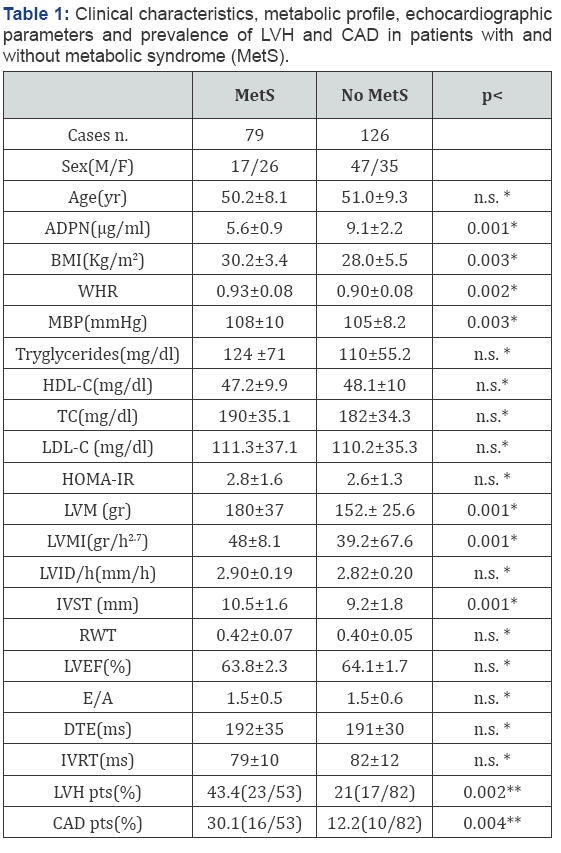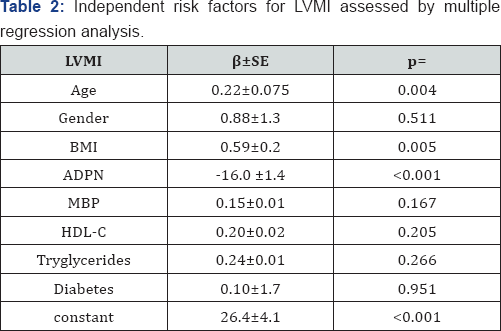Left Ventricular Hypertrophy and Coronary Artery Disease in Subjects with Metabolic Syndrome: Role of Adiposity and Total Plasma Adiponectin_Juniper Publishers
Abstract
Objective: The principal objective of this
study was to demonstrate the role of obesity and adiponectin (ADPN) in
the occurrence of Left ventricular hypertrophy (LVH) in subjects with
Metabolic Syndrome (MetS). The study population consisted of 79 patients
affected by MetS, according to NCEP/ATPIII criteria, and 126 without
MetS, utilized as controls. BMI, waist to hip ratio (WHR), mean blood
pressure (MBP), ADPN levels and HOMA index were measured. Left
ventricular internal diameter (LVID/h), interventricualr septal
thickness (IVST), indexed LVM (LVMI), relative wall thickness (RWT), LV
ejection fraction by echocardiography and diastolic parameters were
calculated.
BMI (p<0.003), WHR (p<0.02), MBP (p<0.03)
LVM, LVMI and IVST (p<0.001) were significantly higher and ADPN
(p<0.001) was significantly lower in subjects with MetS than
controls. In addition, prevalence of LVH (p< 0.002) and Coronary
Artery Disease (CAD) (p<0.004) was greater in subjects with MetS than
controls. ADPN and BMI resulted independently associated with LVMI also
when single components of MetS were includes in the analysis.
Conclusion: Our data are consistent with an
increased prevalence of LVH and CAD in patients with MetS. Increasing
number of MetS components was associated to step-wise increased in LVMI.
ADPN and BMI separately and additively may be considered as the best
predictors of LVH and CAD in these subjects.
Keywords: Metabolic syndrome; Left ventricular hypertrophy; Adiponectin
Abbreviations: ADPN:
Total Plasma Adiponectin; BMI: Body Mass Index; WHR: Waist To Hip
Ratio; MBP: Mean Blood Pressure; HDL-C: High Density Lipoprotein
Cholesterol; TC: Total Cholesterol; LDL: Low Density Lipoprotein
Cholesterol; HOMA-IR: Homeostasis Model Assessment Of Insulin
Resistance; LVM: Left Ventricular Mass; LVMI: Left Ventricular
Mass/Height; LVID/h: Left Ventricular Internal Diameter/Height; IVST:
Interventricular Septal Thcikness; RWT: Relative Wall Thickness; LVEF:
Left Ventricular Ejection Fraction; E/A: Peak Early Transmitral Flow/
Peak Late Transmitral Flow; DTE: E Deceleration Time; IVRT: Isovolumic
Relaxation Time; pts: Patients; LVH: Left Ventricular Hypertrophy; CAD:
Coronary Artery Disease. LVMI: Left Ventricular Mass/Height; ADPN: Total
Plasma Adiponectin; BMI: Body Mass Index; MBP: Mean Blood Pressure;
HDL-C: High Density Lipoprotein
Cholesterol
Introduction
Accumulation of intra-abdominal visceral fat and of
adipocyte's dysfunction are considered the cellular basis of metabolic
syndrome (MetS), associated with heightened risk for cardiovascular
disease and cardiovascular mortality [1-4]. Population-based studies indicated an association between MetS and abnormal left ventricular (LV) geometry [5,6].
It is well known that several factors, both hemodynamic and
non-hemodynamic, may be implicated in the increase of left ventricular
mass (LVM) and wall thickness and thus in the occurrence of LV
hypertrophy (LVH) [7,8].
In this field an important role has been attributed recently to adipose
tissue dysfunction [1-3,9], a term indicating a state of hyper
secretion of pro-atherogenic, pro-inflammatory and pro-diabetic
adipocytokines, which is accompanied by a decreased production of
adiponectin [9].
Adiponectin (ADPN) is an adipocyte-specific protein abundantly present
in the plasma with well known anti-atherogenic, anti-diabetic and
antiinflammatory properties [1-3,10].
Despite these findings, few studies addressed the
influence of circulating ADPN in the development of LVH in subjects with
MetS. The present study was designed to explain the interaction between
ADPN and MetS on the cardiac damage. Accordingly, cardiac parameters
and prevalence of LVH and coronary artery disease (CAD) were evaluated
in patients with and without MetS. The principal objective of our study
was to demonstrate that hypoadiponectinemia might be considered a
nonhaemodynamic factor in the occurrence of LVH in subjects with MetS.
Subjects and Methods
Subjetcs
In this cross-sectional study, 205 consecutive
outpatients referred to our center of hypertension and metabolic disease
at the University of Palermo (Italy) from January 2013 to April 2014
because of BP or metabolic control related problems, were evaluated. The
study population consisted of 79 patients affected by MetS, according
to NCEP/ATPIII criteria [11], and 126 without MetS, utilized as controls.
A written informed consent was collected from all the
subjects recruited. The protocol of this study was approved by the
board of University of Palermo (Italy). Clinic examination, including
medical history, measurements of body weight, height, blood pressure
(BP) and resting electrocardiogram was assessed in all the subjects.
Information regarding medical history, drug use, and alcohol and
cigarette consumption was collected. Exclusion criteria included
alcoholism and psychiatric problems. Body mass index was calculated as
weight divided by squared height and expressed as kg/m2 and WHR by waist/ hip ratio [4].
Blood pressure (BP) was measured according to current recommendations
with an appropriate large cuff in obese subjects. Systolic (SBP),
diastolic (DBP) and mean (MBP) BP were determined. MBP was calculated by
the sum of DBP plus one third of pulse pressure. According to ADA
guidelines, the presence of diabetes was recognized from a fasting
glycaemia >126mg/dl or the use of antidiabetic drugs or insulin [12]. Insulin resistance (IR) was recognized by the evaluation of homeostasis model assessment (HOMA) index.
In all the subjects the occurrence of LVH and the
prevalence of coronary artery disease were evaluated. According to
echocardiographic measurement, all the subjects with LVM normalized for
height to the 2.7 power (LVMI) ≥50g/m2 for men and ≥47g/m2 for women
were considered to have LVH [13].
The diagnosis of CAD was supported by history,
symptoms of typical angina, cardiac markers and specific cardiac
examinations, following guidelines of European Society of Cardiology [13].
Methods
Routine biochemical parameters were detected through
standardized methods. An immunoradiometric assay (Biosource, Belgium)
was used to measure serum insulin. The HOMA-IR was calculated using the
following equation: HOMA-IR= fasting insulin (pmol/L X fasting glucose
(mmol/L)/22.5. IR was defined as an HOMA-IR in the highest quintile of
its distribution [12].
Adiponectin levels were measured by a validated competitive
radioimmunoassay (Linco Research Inc., MO, USA) as previously described [4].
Measurements of left ventricular geometry and
function were assessed by M and B-mode computerized echocardiography
(ESAOTE, Italy). Accordingly, left ventricular internal diameter/ height
(LVID/h), interventricular septum thickness (IVST), LVM normalized for
height to the 2.7 power (LVMI) (14) were calculated. Recognition of LVH
by LVM/h cut-offs has to be preferred since body surface area correction
understimates LVM in the upper range of the body surface area
distribution [14]. The relative wall thickness (RWT) by formula [(PWTd/LVIDd)x2]
and left ventricular ejection fraction (LVEF) were also calculated with
standardized method (4). Diastolic parameters, such as E/A ratio,
isovolumic relaxation time (IVRT) and the deceleration time of E
velocity (DTE) by echo-dopler examination were also calculated.
Statistical Analysis
Data are presented as mean±SD. Comparison between the
groups were analyzed through the Man-Whitney U test was and comparisons
between two proportions by Z test. Linear and multiple regression
analysis were performed to study relationship among independent
variables and LVMI. A p value <0.05 was used as cut-off for
statistical significance. STAT/SE, version 9.2 for Windows (StataCorp.
College Station, Texas), was used to analyze the data.
Results

Clinical characteristics, echocardiographic parameters and prevalence of LVH and CAD are available in Table 1.
Both groups were matched with regard to sex and age. BMI (p<0.003),
WHR (p<0.02), MBP (p<0.03) LVM, LVMI and IVST (p<0.001) were
significantly higher and ADPN (p<0.001) was significantly lower in
subjects with MetS than controls. In addition, prevalence of LVH (p<
0.002) and CAD (p<0.004) was greater in subjects with MetS than
controls (Table 1).
LVMI correlated directly with BMI (r=0.33; p<0.001), MBP (r=0.30;
p<0.001), MetS (r=0.28 p<0.001) and inversely with ADPN (r=-0.55;
p<0.0001). Multiple regression analysis was used to explain the
interaction between ADPN and MetS and to test the independent role of
risk factors for LVMI. ADPN and BMI resulted independently associated
with LVMI also when single components of MetS were includes in the
analysis. (Table 2).

Discussion
Our data indicate clearly that subjects with MetS
were characterized by decreased ADPN, increased LVMI and higher
prevalence of LVH and CAD respect to controls without MetS. The main
finding of the study is the independent inverse relationship between
ADPN and LVMI found by us in subjects with MetS. It is well known that
MetS is often associated with LVH even if its role is partly independent
from the effect of several determinants of LVM and it was not able to
predict LVH independently of increased adiposity [15].
This finding is further supported by the independent LVMI/BMI
relationship reported in this study. In addition circulating ADPN
remained inversely and independently associated with LVMI, also when the
single components of MetS were included in the analysis. To our
knowledge, this is the first study to examine the role of ADPN on the
changes in left ventricular geometry and on the prevalence of LVH and
CAD in subjects with MetS. Our data are consistent with the suggestion
that ADPN might be considered as an important nonhaemodynamic factor
able to explain the occurrence of LVH in subjects at higher
cardiometabolic risk [1-4,10].
These data suggest that increased risk of LVH due to a presence of MetS
seems mediated mainly by adiposity and circulating ADPN which work as a
non hemodynamic factors. Hypoadiponectinemia or functional ADPN
resistance, perhaps secondary to down regulation of ADPN receptors, may
contribute to an exaggerated hypertrophic response to hemodynamic load
and to inappropriate LVH [1,2,16].
Some limitations of this study must be taken into
account. First, our population is made exclusively of patients studied
in the Centre of Hypertension and Metabolic Disease. This selection
“bias” can explain the prevalence of MetS, diabetes, hypertension and
dyslipidemia. Thus, our study is relevant for an important condition
commonly found in “real life” medical practice. Second, we were not able
to take into account all the details of all the different classes and
subtypes of drugs assumed by the patients, which in turn might have
affected the results obtained. However, this is a common limitation of
many published works when “real practice” patients are studied. Third,
it has been designed to be a cross-sectional study. Evaluation of the
cause- effect relationship between ADPN and LVH would require a
prospective study design with a cohort base and larger casistics.
Therefore, we cannot prove causality or predictive ability, but only
discern association.
Conclusion
In conclusion, in our patients with MetS, an
increased prevalence of LVH and CAD has been found. Increasing number of
MetS components was associated to step-wise increased in LVMI. ADPN and
BMI separately and additively contribute to LVH in these subjects.
Accordingly weight loss and increased ADPN levels may be useful to
regress LVH. According to emerging data indicating that ADPN has to be
considered as an important modulator of the adipovascular axis that
affects the cardiometabolic risk profile, from the premetabolic
syndrome, through MetS to overt atherosclerosis and that
hypoadiponectinemia alone may represent an early phenomenon that long
precedes the occurrence of all components of overt MetS [1,3,17],
circulating ADPN might become a new target in the management and
treatment of metabolic syndrome and it should be included among the
criteria utilized to define MetS.
To Know More About Current Research in Diabetes & Obesity
Journal Please click on:
https://juniperpublishers.com/crdoj/index.php
https://juniperpublishers.com/crdoj/index.php



Comments
Post a Comment